During these hot summer months pest problems can become overwhelming if allowed to get out of hand. There are 3 main controls used for keeping pests at bay:
Mechanical – Hand pick insects and eggs off plant.
Biological – Plant certain types of herbs and flowers that attract beneficial insects (this is also known as companion planting).
Chemical – Organic and non-organic chemicals are included in this category.
The struggle between whether or not to spray organic vegetables with chemicals can be a burden. Although chemical pesticides are needed at times, they are over used and can be extremely dangerous to humans, the environment and animals. I recommend using a chemical pesticide as a last resort to save a plant. Be sure to read all labels carefully and discard waste as directed.
“The Bad”
In part 1 we discussed the biological pest control options by attracting “The Good” bugs into our garden.
The bad bugs, if allowed to get out of hand can turn our happy gardening experience into a frustrating nightmare! In part 2 we will go over how to combat the “enemy” with natural pest control methods that are inexpensive and can be made from every day ingredients in our own home, keeping our garden free of chemicals! These are my top 10 pests with natural solutions!
Snails
Snails can be detrimental to the vegetable and flower gardens. They eat pretty much everything and fast because they can multiply quickly! It’s best to get a handle on this pest as soon as possible since they can lay up to 100 eggs within a few days. One of the best ways to get rid of snails is to go out very early in the morning as the sun rises and hand pick snails off plants throwing them into a soapy bucket of water or a seal-able plastic bag to be thrown into an outside garbage can. Another way to rid snails is to put beer or a sugar/yeast and water mixture into a pie plate or tuna cans. Dig the shallow dish into the ground so it is flush with the soil. The snails will be attracted to the beer or sugar/yeast water and drowned. If the infestation is really bad use snail bate, a chemical solution, that can be used to get control of the problem.
Aphids
Aphids are detrimental in numbers! A single aphid can produce up to 600 billion offspring! As you can see from the picture above the damage of many plants can kill a plant or bring it close to death. Some symptoms of aphids on plants are wet honeydew secretions, sticky looking leaves with hundreds of aphids on the under side of them, curling leaves and blossoms that begin become necrotic, making them turn black or even small webbing all over. Aphids feed on sap from shoots, leaves, flowers and buds. These little guys are too little and to large in numbers to mechanically be removed. I like to make a homemade recipe with garlic and liquid soap to spray on them, suffocating their soft bodies.
To make the garlic spray puree 1 bulb of garlic with 1/2 cup water. Add 2 tablespoons plant based liquid dish washing soap and cayenne pepper for a stronger concoction. Allow to steep for a few hours or over night. Pour the mixture through a sieve and cheese cloth. Add more water and the garlic mixture to a spray bottle and spray! Apply every 3-4 days until the problem is eradicated.
Colorado Potato Beetle
These voracious beetles can strip a plant down to it’s roots if uncontrolled. They like to eat potatoes, eggplant, peppers and tomatoes. The best way to combat these pests is to use a number of methods. First pick as many of the beetles by hand, rotate crops every year and use BT (Bacillus thuringiensis tenebrionis) a natural occurring bacteria that makes certain insects sick and die. This product can be purchased at your local nursery.
Japanese Beetles, Grubs and Billbugs
These beetles are not our friends! Especially the Japanese beetle! It will destroy everything in it’s path! The Japanese beetle has a beautiful coppery/green shell. Billbugs and grubs mostly feed on turf grass. One of the best ways to prevent this problem from occurring is to water properly by not watering too much. For all these pest one of the best ways to control them is to use diatomaceous earth or DE. DE is a nontoxic, organic concoction made of the fossilized remains of tiny one-celled marine animals called diatoms. Chemically, it’s almost pure silicone dioxide. To humans, DE feels really soft to the touch, but to grubs it’s like razor wire that literally shreds them as they touch it. DE can be found at any health food store or local nursery.
Sprinkle 1/2 cup of DE to a square foot of soil or sod and mix it into the soil to a depth of about six inches. DE can cause respiratory problems, so wear a mask and work with it on a non-windy day. DE can also harm beneficial insects, such as earthworms, so use only where grubs are a problem.
Spider Mites
Spider mites are microscopic and can sometimes be seen with the naked eye. What is most prominently seen are their webs. They feed on leaf sap similar to aphids. Watch for speckling or bronzing color on the leaves. The garlic spray I mentioned above is effective as well as using rubbing alcohol. Mixing alcohol with water and spraying your plants will help get rid of spider mites naturally without damaging the plants. You can mix 1 part alcohol to 1 or 2 parts water for maximum effectiveness. You can also use a cotton ball dipped in straight rubbing alcohol to gently rub the spider mites on the bottom of the leaves of your plants that are indoors. Alcohol will kill the spider mites on contact. Remember to use this method in the evening so the alcohol will evaporate without the sun causing burn to the leaves.
Peach Tree Borer
The dreaded peach tree borer can be difficult to fight off especially if the tree is already infested! It can be very sad to watch our beloved peach trees slowly die overtime from this nasty pest! In the picture on the left you can see the adult. She will lay her eggs at the base of the tree and the larva will borer into the bark of the tree and feed on the wood. The best way to prevent this problem from happening is to faithfully cultivate the soil 2-3 feet from the trunk out and 2-3 inches deep every 2 weeks during the late spring and summer. This will expose the eggs to the elements and they will not be able to survive. Planted garlic and other onion family members have been known to ward off the peach tree moth from laying eggs because of its strong odor.
Squash Bugs
My arch nemesis! Squash bugs can take over in no time if you don’t know what you are looking for! These life sucking insects literally suck the water right out of the plant in just a few hours, leaving it looking like it hasn’t been watered in weeks. The plant leaves become droopy, necrotic and black. A good fierce spray of the hose will bring the adults out from underneath their hiding places making it easier to hand pick them. Be sure to have a soapy bucket of water for them to drowned in! The copper colored eggs can be found on the undersides of the leaves in a cluster. Be sure to remove as many as you can and crush them, then throwing them into the bucket of soapy water. It is best to go out every day for a few minutes and remove them by hand until they are all gone. If that isn’t good enough try using Neem Oil. This organic chemical comes from the seeds of the neem tree. Neem oil interferes with insect hormones leaving them unable to grow and reproduce. When using any pesticide, including organic products, be sure to read all labels and use as directed. Neem oil is also toxic for honey bees. It is best to apply before 7am or after 7pm when most beneficial insects have left for the evening.
Leaf Miners
Leaf miners love to eat spinach, Swiss chard, beet greens and other leafy greens. The adult fly lays little white eggs on the back of the leaf. Once hatched they burrow into the inner layer of the leaves, leaving trails of dead vegetation in their wake. The best way to keep these under control is to plant nectar and pollen loving plants that attract parasitic wasps. See part one for a brief list. Using fabric row covers is an excellent way to keep them away. Cover in the spring and bury the edges of the row cover around the grow box or soil. Use a light enough fabric to allow water and sun penetration for growth. If you choose not to use the fabric row cover it is important to look for the eggs as the first of the greens start to grow. Remove them if you see any until the problem has stopped. Neem oil can be used as a last resort.
Tomato Horn Worm
Just thinking about these buggers gives me the willies! They can be 3-4 inches long and have massive appetites! A hawk or sphinx moth lays the eggs on plants like peppers, tomatoes and potatoes. They blend in well with the green foliage and can be difficult to see. If detected early enough the plant will survive. The best way to control the worm is to hand pick them and throw them into a bucket of soapy water (definitely wear gloves). What is even cooler is when the braconid wasp lays it’s little white eggs on the worm feeding on it’s flesh until it’s ready ready to pupate. If such projections appear it is best to leave the horn worm alone and let nature take care of nature. This way you will have more beneficial insects to fight off the bad!

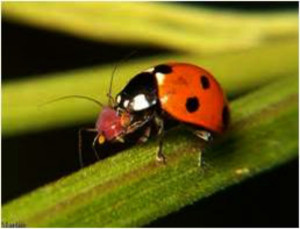
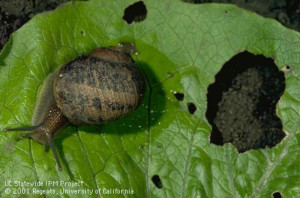
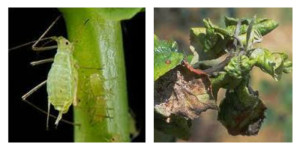
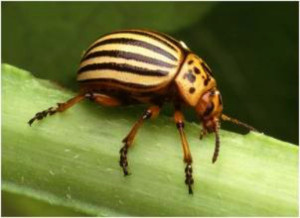
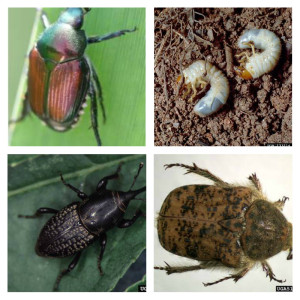
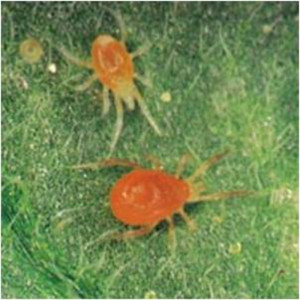
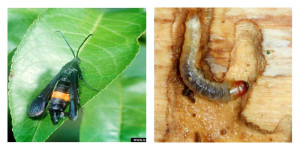
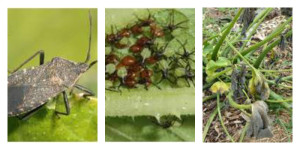
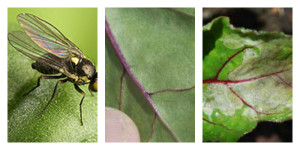
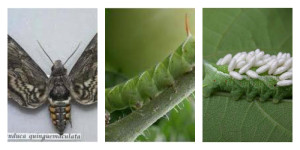
Snails are the “bane” of my existence. We were over whelmed by them at our last place and we hoped to be rid of them when we moved. But no such luck!! We have a field that is flood irrigated just behind us and they hang out there all day and then head to our yard to munch on our garden all night!! Ugh!!
Terrible! Have you tried DE on the nights you don’t water? You may have to go the snail bate route…